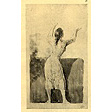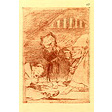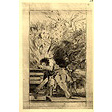
The draftsman's desk
Artistic techniques







 Chinese-ink wash |
The main feature of drawing is the use of strokes or lines. Compared to other artistic techniques, it stands out for the brevity in its execution. Generally, it is small in size.
The usual support for drawing is paper. For notes and pen-and-brush drawings, white, fine-grained, smooth-surfaced paper is preferred. Coarse-grained paper, colored or not, is best suited for pencil, charcoal, or pastel drawing. 1) Ink drawingPen drawing uses two different types of inks:a) The most common is the Chinese ink, which is made of lampblack dissolved in oil, gum arabic and binders. Once mixed with water, it produces gray tones. b) Sepia is an ink that is obtained from the substance contained in a gland of the cephalopod of the same name. This substance is diluted in water in different degrees of concentration, and gum arabic is added. Besides constituting the raw material for pen drawing, ink is also the basis for two other drawing techniques: paintbrush and wash. Paintbrush is used with pure or watered-down inks. Wash is obtained from Chinese ink or colored inks, which are diluted in water and applied with a brush. The most frequent washes in Goya are those of brown ink, as they lend themselves very well to his usual contrasts of light and shades. It is common to find the various techniques mixed in the same drawing. Pen and ink are used to trace lines and figures, and brush and wash to nuance attitudes and contrasts. 2) Pencil drawingPencil drawing is defined by the material used: black, white and colored pencils, to which are added colored chalks. Charcoal is produced with sticks obtained from the slow combustion of wood, to which resins and alcohol are added to prolong its duration. Sanguine is a red pencil made of ferruginous clay. The kind of black pencil used in Goya's times was the English graphite, whose lead was made with lead. In 1970 a new fabrication technique was invented for making pencils: the so-called Conté pencil. It is a conglomerate of graphite powder and clay, which is still used today for the manufacture of ordinary pencils. See alsoBibliographyMaltese, C. (coord.). Las Técnicas Artísticas. Madrid, 1981.Bonet Correa, A. (coord.). Historia de las Artes Aplicadas e Industriales enEspaña. Madrid, 1982. Gallego, A. Historia del Grabado en España. Madrid, 1979. Lemaire, J ; Monnier, G ; Rose, B. El Dibujo. Barcelona, 1979. Marisa Cancela |
|
 Red pencil |
||
 Pen and sepia ink |
||
 White pencil on yelow greyish paper |
||
 |
InfoGoya 96 is an initiative of the University of Zaragoza, sponsored by the Institution Fernando el Católico of the Deputation of Zaragoza on an Apple Internet Server donated by Apple Computer. |    |